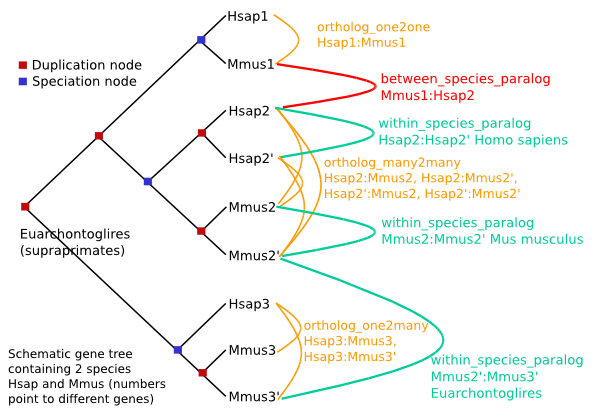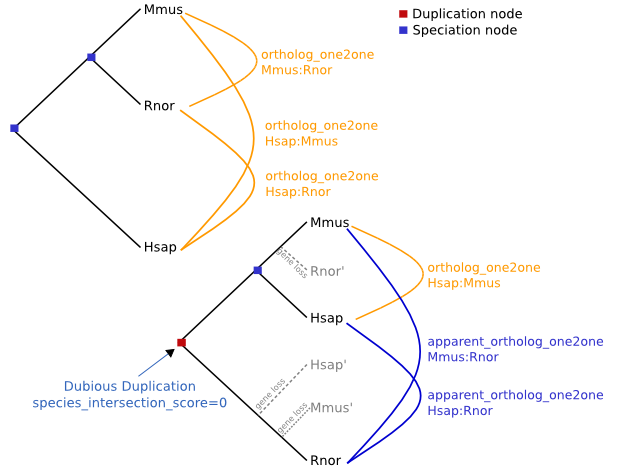Gene Orthology/Paralogy prediction method
The gene orthology and paralogy predictions are generated by a pipeline where maximum likelihood phylogenetic gene trees (generated by TreeBeST) play a central role. They aim to represent the evolutionary history of gene families, i.e. genes that diverged from a common ancestor. These gene trees reconciled with their species tree have their internal nodes annotated to distinguish duplication or speciation events.
This methodology was published in EnsemblCompara GeneTrees: Analysis of complete, duplication aware phylogenetic trees in vertebrates. Vilella AJ, Severin J, Ureta-Vidal A, Durbin R, Heng L, Birney E. Genome Research 2008 Nov 4. Please cite this publication if you use the homologies from Ensembl.
There is a clear concordance with reciprocal best approaches in the simple case of unique orthologous genes. However, the gene tree pipeline is able to find more complex one-to-many and many-to-many relations. This, for instance, significantly raises the number of Teleost (bony fish) to Mammal orthologs and has even more dramatic effects on Fly/Mammal or Worm/Mammal orthologous gene predictions. Using this approach, we are also able to "time" duplication events which produce paralogs by identifying the most recent common ancestor (=taxonomy level) for a given internal node of the tree.
The gene orthology and paralogy prediction pipeline has 6 basic steps:
- Load the longest translation of each gene from all species used in Ensembl
- run WUBlastp+SmithWaterman of every gene against every other (both self and non-self species) in a genome-wise manner
- Build a sparse graph of gene relations based on Blast scores and generate clusters using hcluster_sg1
- For each cluster, build a multiple alignment based on the protein sequences using a combination of multiple aligners, consensified by MCoffee2
- For each aligned cluster, build a phylogenetic tree using TreeBeST3 using the CDS back-translation of the protein multiple alignment from the original DNA sequences**. A rooted tree with internal duplication tags is obtained at this stage, reconciling it with the species tree in ensembl-compara/scripts/pipeline/species_tree_njtree.taxon_id.nh (refer to section "Create the species tree file" in ensembl-compara/scripts/pipeline/README-genetree for a more detailed explanation).
- From each gene tree, infer gene pairwise relations of orthology* and paralogy types.
* There is an extra optional step which calculates the dN/dS values for the orthology relationships of closely related pairs of species. We use codeml in the PAML4 package (model=0, NSsites=0) for this (ensembl-compara/scripts/homology/codeml.ctl.hash).
We only calculate these dN/dS values for closely-related pairs of species. When the species evolutionary distance is too large, the saturation of the dS values biases the estimated dN/dS ratio. For each pair of species we calculate a threshold on dS which is 2 * median(dS). When the dS of a given ortholog gene pair is larger than this threshold, we mask out the dN/dS ratio.
** A description of the tree building method in TreeBeST: the CDS back-translated protein alignment (i.e., codon alignment) is used to build 5 different trees:
- a maximum likelihood (ML) tree built using phyml, based on the protein alignment with the WAG model;
- a ML tree built using phyml, based on the codon alignment with the Hasegawa-Kishino-Yano (HKY) model;
- a neighbour-joining (NJ) tree using p-distance, based on the codon alignment;
- a NJ tree using dN distance, based on the codon alignment; and
- a NJ tree using dS distance, based on the codon alignment.
For (1) and (2), TreeBeST uses a modified version of phyml release 2.4.5 which takes an input species tree, and tries to build a gene tree that is consistent with the topology of the species tree. This "species-guided" phyml uses the original phyml tree-search code. However, the objective function maximised during the tree-search is multiplied by an extra likelihood factor not found in the original phyml. This extra likelihood factor reflects the number of duplications and losses inferred in a gene tree, given the topology of the species tree. The species-guided phyml allows the gene tree to have a topology that is inconsistent with the species tree if the alignment strongly supports this. The species tree is based on the NCBI taxonomy tree (subject to some modifications depending on new datasets).
The final tree is made by merging the five trees into one consensus tree using the "tree merging" algorithm. This allows TreeBeST to take advantage of the fact that DNA-based trees often are more accurate for closely related parts of trees and protein-based trees for distant relationships, and that a group of algorithms may outperform others under certain scenarios. The algorithm simultaneously merges the five input trees into a consensus tree. The consensus topology contains clades found in any of the input trees, where the clades chosen are those that minimize the number of duplications and losses inferred, and have the highest bootstrap support. Branch lengths are estimated for the final consensus tree based on the DNA alignment, using phyml with the HKY model.
Homology types
- Orthologues
- any gene pairwise relation where the ancestor node is a
speciation event. We predict several descriptions of orthologues:
- ortholog_one2one
- ortholog_one2many
- ortholog_many2many
- apparent_ortholog_one2one (is a special case, see below)
- Paralogues
- any gene pairwise relation where the ancestor node is a duplication event. We predict several descriptions of paralogues:
- within_species_paralog
- between_species_paralog

A within_species_paralog corresponds to a relation between 2 genes of the *same* species where the ancestor node has been labelled as a duplication node e.g. H2:H2', M2:M2' but does not necessarily mean that the duplication event has occurred in this species only. For example, M2':M3' are also within_species_paralog but the duplication event has occurred in the common ancestor between species H and species M. If H is human and M Mouse, the taxonomy level "times" the duplication event to the ancestor of "Euarchontoglires".
A between_species_paralog corresponds to a relation between 2 genes of *different* species where the ancestor node has been labelled as a duplication node e.g. M1:H2 or M1:H3. Special cases of between_species_paralog can be singled out where they can be characterised as one2one relations. Such cases are then relabelled apparent_ortholog_one2one. Apparent orthologs can be the results of real duplication followed by gene loss (as shown in the picture below), but can also be the results of a wrong gene tree topology and wrong duplication node labelling. The remaining between_species_paralogs only reflect long-distance relations aren't of much use for most phylogenetic/family analyses.

Notes and References
- Hcluster_sg : hierarchical clustering software for sparse graphs. hcluster_sg performs hierarchical clustering under mean distance. It reads an input file that describes the similarity between two sequences, and groups two nearest nodes at each step. When two nodes are joined, the distance between the joined node and all the other nodes are updated by mean distance. This procedure is iterated until one of the three rules is met: (a) Do not merge cluster A and B if the total number of edges between A and B is smaller than |A|*|B|/3, where |A| and |B| are the sizes of A and B, respectively. This rule guarantees each cluster is compact. (B) Do not join A to any other cluster if |A| < 500. This rule avoids huge clusters which may cause computational burden for multialignment and tree building as well. (C) Do not join A and B if both A and B contain plant genes or both A and B contain Fungi genes. This rule tries to find animal gene families. TreeFam clustering is done with outgroups. Hcluster_sg also introduces an additional edge breaking rule: removes an edge between cluster A and B if the number of edges between A and B is smaller than |A|*|B|/10. This heuristic rule removes weak relations which are quite unlikely to be joined at a later step.
- Wallace IM, O'Sullivan O, Higgins DG, Notredame C. "M-Coffee: combining multiple sequence alignment methods with T-Coffee." Nucleic Acid Research. 2006 Mar 23;34(6):1692-9. The current aligner sets are divided into 3 levels, each alignment is tried with the first, and retried on the second or third on failure. First level: mafftgins_msa, muscle_msa, kalign_msa, probcons_msa; second level: mafft_msa, muscle_msa, clustalw_msa, kalign_msa; third level: mafft --auto.
- Li, H et al., TreeBeST: http://treesoft.sourceforge.net/treebest.shtml. Manuscript in preparation. TreeBeST was previously known as NJTREE.
- Yang, Z. "PAML: a program package for phylogenetic analysis by maximum likelihood" Comput Appl Biosci. 1997 Oct; 13(5):555-556.

